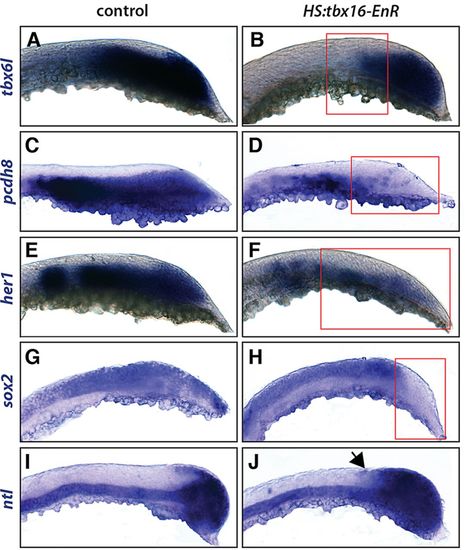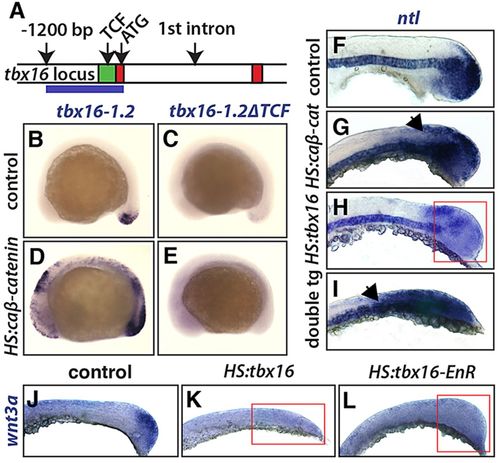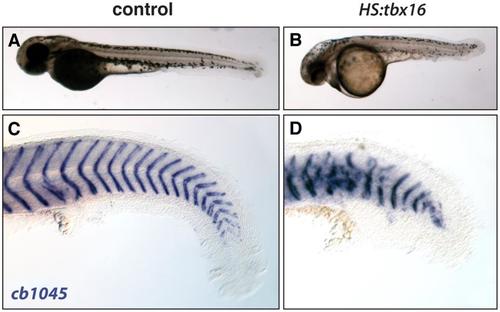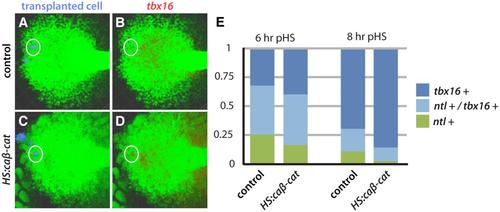- Title
-
Wnt signaling and tbx16 form a bistable switch to commit bipotential progenitors to mesoderm
- Authors
- Bouldin, C.M., Manning, A.J., Peng, Y.H., Farr, G.H., Hung, K.L., Dong, A., Kimelman, D.
- Source
- Full text @ Development
|
tbx16 expression causes cells to exit the tailbud. (A) Outline of the assay used to test and quantify the ability of ectopic tbx16 to accelerate exit from the progenitor zone. (B,C) Overlays of transplanted cells labeled with fluorescent dextran (green) on a bright-field image from wild-type (B) or HS:tbx16 (C) donor zebrafish embryos at 36 hpf. (D) Quantification of the most posterior somite occupied by a fluorescently labeled cell with fiber-like morphology in embryos heat shocked at the 10 ss. Data are significantly different (Mann-Whitney U-test, P<0.05). |
|
tbx16 expression represses genes involved in maintaining the progenitor zone. (A) Summary of changes in gene expression after the induction of ectopic tbx16 (based on the data in supplementary material Fig. S3 and Table S1). Arrows indicate the number of hours post-heat shock (HS) and the colors represent expansion (green), constriction (red) or no change (yellow) to expression, with intermediate shades marking the degree of difference. PM, progenitor markers; EDM, early differentiation markers; LDM, late differentiation markers. α-Tbx16 indicates Tbx16 assessed by immunostaining. (B-G) In situ hybridization shows changes to gene expression in the tailbud of HS:tbx16 (C,E,G) and control (B,D,F) embryos at 6 h after heat shock. The arrow (C) points to expansion of pcdh8 and the red boxes (E,G) highlight the reduction of sox2 and ntl in the tailbud. |
|
tbx16-EnR expression represses sox2 and activates ntl. In situ hybridization shows changes to gene expression with HS:tbx16-EnR (B,D,F,H,J) or in control (A,C,E,G,I) 4 h after heat shock. The red boxes (B,D,F,H) highlight the reduction of tbx6l, pcdh8, her1 and sox2 in the tailbud and the arrow (J) points to an expansion of ntl. |
|
tbx16 is Wnt responsive. (A-C) Immunofluorescence shows cells in the tailbud with nuclear β-catenin (nβ-catenin; A, orange; cytoplasmic and membrane-bound β-catenin have been eliminated from the image; see Materials and Methods) or Sox2 protein (B, orange). DAPI labels nuclei (blue). The highest levels of nβ-catenin and Sox2 are white and the lowest levels are purple. (C) A composite image shows that there is little overlap between the Sox2 domain (red) and the nuclear β-catenin domain (green). (D-G) Fluorescent whole-mount in situ hybridization shows tbx16 (red) and ntl (green) with HS:caβ-catenin (F,G) and in control (D,E) at 4 h post-heat shock. Single slices (D,F) and maximum intensity projections (E,G) are shown. In all images, anterior is to the left and posterior is to the right. |
|
Wnt drives tbx16 reporter expression and tbx16 represses Wnt. (A) The zebrafish tbx16 locus, showing exons 1 and 2 (red) and a conserved region of the tbx16 promoter (green), which contains two predicted TCF binding sites (see supplementary material Fig. S5). The blue line marks the region used for the tbx16-1.2 construct. (B-E) Whole-mount in situ hybridization shows reporter expression from the tbx16-1.2 transgene with HS:caβ-catenin (D) and in control (B). Another reporter line with mutations in both of the predicted TCF sites (tbx16-1.2ΔTCF) showed no expression with (E) or without (C) HS:caβ-catenin. (F-I) In situ hybridization shows wild-type ntl expression (F; n=22 embryos) and the changes in ntl expression after heat shock induction of HS:caβ-catenin (G; n=16 embryos), HS:tbx16 (H; n=11 embryos), and both transgenes (I; n=9 embryos). The arrows (G,I) highlight the expansion of ntl and the red box (H) highlights the reduction of ntl. (J-L) In situ hybridization shows wild-type wnt3a expression (J) and the loss of wnt3a expression after heat shock induction of HS:tbx16 (K) or HS:tbx16-EnR (L). Red boxes (K,L) highlight the reduction of wnt3a in the tailbud. |
|
caβ-catenin expression causes early exit of cells from the progenitor zone. (A,B) Overlays of transplanted cells labeled with fluorescent dextran (green) onto a bright-field image from control (A) or HS:caβ-catenin (B) donor embryos into wild-type hosts. (C) Quantification of the most posterior somite occupied by a fluorescently labeled cell in host embryos. Data are significantly different (Mann-Whitney U-test, P<0.05). |
|
Ubiquitous tbx16 expression causes organism-wide defects. At 36 hpf, bright field images show that control siblings (A) are longer than embryos with the HS:tbx16 transgene (B) after heat shock. In situ hybridization with cb1045, a probe that normally marks the somite boundaries in control siblings (C), shows severe disruptions in somite formation in HS:tbx16 embryo (D). The left-most somite shown in C is the 14th somite and the left-most somite shown in D is the 13th somite. All embryos were heat shocked at the 12 ss. |
|
Ectopic Tbx16 is ubiquitous, labile and peaks at 4 hours post-heat shock. In control (A-C) and HS:tbx16 (D-F) embryos, immunofluorescence shows that Tbx16 protein levels have increased by 2 hours post-heat shock (A, D) with a peak at 4 hours post-heat shock (B, E), and that levels of Tbx16 have largely returned to normal by 6 hours post-heat shock (C, F). Inset in D shows ectopic Tbx16 in the notochord and neural tube (marked by arrowheads) when compared to the control inset in A (both dorsal views of the tailbud); arrows in E, F highlight the telencephalon, which retains ectopic Tbx16. |
|
Gene expression after heat shock activation of HS:tbx16. Whole mount in situ hybridization data used for the summary of changes to genes after the expression of ectopic tbx16 (shown in Figure 2A). Because of the large number of embryos screened for this analysis, transgenic embryos were not separated from their nontransgenic siblings prior to in situ hybridization. A minimum of 30 embryos was used for each condition. In all cases except where noted as Not Diff. (not different), approximately 50% of the embryos matched previously published wild-type expression patterns and 50% showed the altered pattern. See Table S1 for quantification of the results. |
|
Wnt signaling regulates ntl independently of tbx16. Expression of ntl is expanded in HS:caβ-catenin when compared to control embryos (A, B; 17 control and 15 transgenic); with tbx16 MO, ntl is similarly expanded in HS:caβ-catenin when compared to control embryos (C, D; 17 control and 26 transgenic). |
|
Transplanted HS:caβ-catenin cells activate tbx16 cell-autonomously. (A, C) Transplanted cells in the progenitor population are identified in blue. Cell-autonomous expression of tbx16 is not apparent in control cells (B) but is apparent in cells with HS:caβ-catenin (D). (E) Quantification of all transplanted cells within the tailbud from the same experiment as shown in A-D. At both 6 and 8 hrs post-heat shock, cells expressing caβ-catenin were less likely to express ntl and more likely to express tbx16 than control transplanted cells. At 6 hours post-heat shock, 151 cells were analyzed from 16 embryos (control) and 190 cells were scored from 19 embryos (HS:caβ-catenin); the distribution of control cells was different from HS:caβ-catenin cells (chi-square; P=0.052). At 8 hours post-heat shock, 131 cells were analyzed from 15 embryos (control) and 99 cells were scored from 14 embryos (HS:caβ-catenin); the distribution of control cells was significantly different from HS:caβ-catenin cells (chi-square; P<0.01). |
|
sox2 and ntl increase when Tbx16 and Msgn1 are depleted. Whole mount in situ hybridization shows a decrease in pcdh8 expression in embryos (A, B; 13 controls and 12 morphants) injected with tbx16 MO;msgn1 MO (B). sox2 expression (C, D; 11 controls and 13 morphants) and ntl expression (E, F; 16 controls and 10 morphants) increase in embryos injected with tbx16 MO;msgn1 MO (D, F). |












